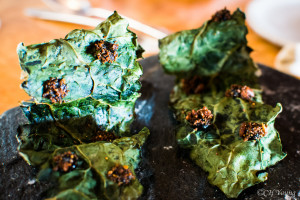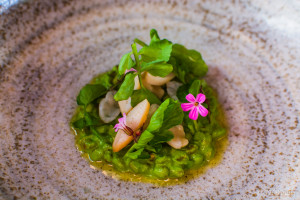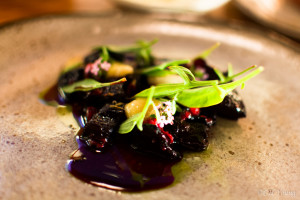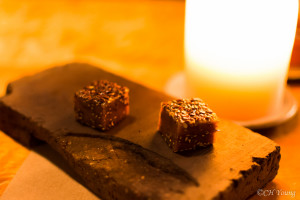For those of us in Seattle, getting to Willows Inn is pretty easy yet it still involves advanced planning because it’s a two-to-three hour drive and reservations are booked months in advance. On the drive north there’s an opportunity to take the scenic Chuckanut Drive on the way to Bellingham and then a whopping six minute ferry ride to Lummi Island. I’ve read tales of people making the journey, having dinner and then heading back to Seattle that very night, but that’s definitely not the way to do it. It’s worth staying overnight at the inn so you don’t have to skimp on the drinks or feel rushed by the ferry schedule. That being said, it’s still an easier commute than going through airport security to fly there from another part of the country or the world, despite the fact that The New York Times claimed it was one of the ten restaurants in the world worth a plane ride to dine at. A bold statement, and one that we needed to explore for ourselves – no plane ride required.
So what makes the Willows Inn so special? The inn has been around for a hundred years and was a well-loved restaurant by island locals and visitors alike, but when both the inn and its owners’ marriage fell on hard times during the recession, owner Riley Starks placed a help wanted ad on Craigslist for a new chef. Turning the inn into a world-class restaurant was the furthest thing from his mind, he was just trying to stay afloat; but then he got a reply from Blaine Wetzel. Originally from Olympia, Washington, the then-twenty-four year old was working as chef-de-partie at Noma in Copenhagen, Denmark. Noma focuses on seasonal, locally foraged cuisine, sometimes taking it to startling levels by serving, for example, a dish with live ants (it’s said they taste like lemon), and it’s considered one of the best restaurants in the world. Although it dropped to the number two position earlier this year, it has been named number one three years in a row, taking over the reign of elBulli after Chef Ferran Adria shuttered its doors. Starks had never heard of Noma before, but after looking at its website he decided to hire Wetzel sight unseen, and Wetzel accepted not having an opportunity to inspect his new kitchen or the island he would soon be calling home. And that is the story that got the culinary world talking about the new young chef at Willows Inn, on remote Lummi Island in the San Juan archipelago.
Since then, Chef Wetzel has proved his culinary chops, being named one of Food and Wine’s Best New Chefs in 2012, and a James Beard award nominee three years in a row including the Rising Star Chef of the Year in 2013. With that in mind, I couldn’t help but draw some comparisons between the above-mentioned elBulli and its famed chef and the story of Willows Inn and Blaine Wetzel as we were sitting on the porch in anticipation of an amazing meal. elBulli was also a well-loved restaurant with a long history of serving good quality food to tourists coming to the area for a seaside vacation. Both restaurants are located in locales with abundant natural, edible resources. The long winding road to get to elBulli, in a remote location a couple of hours north of Barcelona, is often described as treacherous. Its front porch, where diners would gather for drinks, overlooks the Mediterranean Sea and is where the view of the sunset would disturb the timing of the tasting menu. And finally, there’s the similarity of the chefs’ stories. Adria joined the elBulli kitchen as a line cook at the young age of twenty-two, and just eighteen months later took over the kitchen as head chef, going on to making global culinary history ever since. Chef Wetzel chose to take over a restaurant at a remote island inn, certainly not a destination for fine dining, when we could have gone to any major city in the U.S. to cook.
Starting at 7pm sharp, guests were escorted into the dining room table-by-table. As the last couple to be seated, we were happy to find ourselves in a small side room that had only three tables and was right off the kitchen. Craig was told this was the only available table left when he made the reservation, and we thought it would either be the best seats in the house with a unique perspective or it would feel like a back room where they were trying to shove in a few additional diners. Fortunately, it was the former. More intimate and cozy than the main dining room, it had a great view straight into the kitchen.
A menu was on the table that listed the night’s five-course menu, but what it didn’t even hint at was the dozen or so other bites that would also be served over the course of the evening. The menu gave a shout out to some of the local vendors who provided ingredients, a key component to the Willows Inn concept. Taking what Chef Wetzel learned at Noma, the menu consists of ingredients foraged, fished, and farmed within the nine square miles that make up Lummi Island. What that means for the diner is an extreme version of Northwest cuisine, with everything as seasonal, fresh, and local as can be. There are many fine examples of Northwest cuisine throughout Washington and Oregon – a region blessed with a wide array of local, indigenous ingredients, and people who know how to cultivate them sustainably, humanely, and organically – but this meal was different. It took Northwest cuisine to a place I had never experienced and didn’t know it could go.
The procession of small bites – to be eaten primarily with fingers – began as soon as we were seated when a small wooden box was placed in front of each of us. As we removed the lids a billow of smoke rose, revealing one perfect, smoked mussel on a bed of local rocks. The scent was intoxicating and I don’t think I’ve tasted a better mussel. This was followed by the most delicate and crispy kale I’ve tasted, dotted with a truffle emulsion and rye dust. Forget about any kale chips you’ve ever had before, because there is no comparison. Other snacks followed, including a single pickled oyster with sauerkraut brine and sorrel; a delicate, crispy crepe with steelhead salmon roe; a raw weathervane scallop with creamed dill and scarlet mustard leaves; crispy halibut skin; and then a single, perfect grilled shitake mushroom with sea salt.
Some of these might sound like common things you’ve eaten before, but each tasted like the absolute essence of what it was; staying true to its origin yet turning each bite into a delightful and unique experience. The mushroom tasted like the forest floor. The oyster tasted like the sea. This brings me to another comparison with Chef Adria, who said, “It’s about purity, purity of flavor.” To be clear, I’m not comparing the food of these two chefs. Although I haven’t been to elBulli, I have been to other Adria restaurants, where the food is more about the process of transformation and deconstruction to get to that purity of flavor. At Willows Inn, it’s about finding that purity in the thing itself. In both cases, it seems the goals of the food and a diner’s experience of it – along with the chef’s journey to their respective restaurants – share many similarities that I can’t help but find intriguing.
The first official course arrived at our table. Consisting of organic grains with geoduck and upland cress, it was the perfect interpretation of early summer. A snack of smoked sockeye salmon followed. For those of us who live in the Northwest this may not sound exceptional, but I have never tasted smoked salmon like this. Smoked for eight hours over alderwood and brushed with brown sugar and butter, each bite was the perfect balance of fish, smoke, and wood. The intensity developing with each bite, its texture was meaty and rich, and a better example of smoked salmon simply can’t exist. The second course that followed initially didn’t look particularly inspiring. Described as “Dungeness crab with braised seaweed in a broth of crab and browned butter,” it looked like some cooked greens in a non-descript broth. Maybe that was an intentional foil because hidden underneath the seaweed was the sweetest, most delicate crab I’ve ever tasted. The browned butter with its slightly nutty flavor was a perfect complement to the sweetness of the crab, and the seaweed added the perfect hint of the salty sea. This may or may not have been the best dish of the evening, but it was the most surprising and caught me completely off-guard. There was so much delight in this dish that after my first bite I exclaimed I thought I was going to cry.
The next dish was a bread course served as an intermezzo. It was warm and familiar, but what made it extra special was the home-churned butter and chicken pan drippings. Dipping the bread in the drippings like you would olive oil, it was rich and savory and a way “to not let anything go to waste,” as our server told us. And speaking of service, the staff was welcoming and friendly, happy to answer questions and talk about the food. The service was choreographed to rotate servers for different courses. In addition to the front of house staff, the kitchen staff served several of the courses including Chef Wetzel himself. The atmosphere at Willows Inn is relaxed and informal, yet still intimate, and it was clear to everyone that we were part of something really special.
Each bite of the dried beets with lingonberries and bone marrow emphasized a different sensation and was another beautiful and delicious interpretation of the season; the earthiness of the beets and sorrel, the tart sweetness of the berries, the rich fattiness of the marrow. About this time we noticed diners getting up from their tables and going out onto the porch to watch the sunset, so we joined them. It was a stunning end to a gorgeous day. If the majority of diners getting up interrupted the service flow, it wasn’t apparent. The waitstaff told us it was a common occurrence on days like this, and oftentimes they too go out with cameras in hand to take in the sunset. With a menu so focused on the ingredients of the surrounding island, it only seemed appropriate to enjoy the last glimpse of a brilliant sun shimmering on the water as it headed westward for the night.
As we walked back to our tables we were greeted with our final main course, consisting of king salmon served with wild beach herbs and a puree of celery root – another lovely blend of ocean, earth and early summer. We were next served a gorgeous and refreshing pre-dessert of wild rose petals and salmonberries with rose granita. The perfume of the roses and the icy-cold of the granita was a perfect palate cleanser. Tempered by the berries it was not too overpowering and you instantly felt like you were strolling through a rose garden. Dessert – steamed rhubarb with juniper tips and angelica – was served next with flavors more earthy than sweet in keeping with the overall concept of the menu. Caramels with flax seed were served as a final mignardise to end the meal on a very subtle sweet note. If a diner were hoping for rich chocolate or even the natural sweetness of most fruits, that was not to be found in these dessert courses, but they tied into the menu and felt like a true extension of the overall concept rather than an abrupt change in direction based on what might be expected.
We chose to have the wine pairing with our dinner and each of the five pours was a lovely complement to the meal. Maybe we had a lot to drink but it was a little surprising to find our bar bill almost matched our food bill, and if there was any disappointment at all on this night it might have been that. That said, I don’t think I would order differently next time, although I might be curious to try their wine pairing alternative, which is a juice pairing. It wouldn’t reduce the bill by much, but with flavors like cucumber, gooseberry, sorrel, carrot, and elderflower, I’m sure they are as complementary to the food as the wine.
Overall, this was such a special meal from the time we left our house to reach our island destination to the time we left. There is no other place like this in the Pacific Northwest. Yes, there is great food, but this is cooking and creativity on a different level. It’s important to remember that Chef Wetzel, who appeared so humble and almost seemed surprised when we complemented him, is only twenty-seven years old. His abilities and creativity are only going to further blossom with each passing season. Now that he is an owner at Willows Inn he has a stake in staying put for awhile and hopefully won’t be heading off to New York or San Francisco anytime soon. The Northwest should have a dining experience like this; an homage to the natural abundance of what’s available in its landscape. Each bite and each dish we had was the epitome of that singular item served; and while I’m sure I’ll have salmon, and mussels, and crab elsewhere, I can’t imagine they’ll ever be able to compare. There was such a purity of taste and sense of place that I haven’t experienced before and I don’t know if it could exist anywhere else in the world.
 kimpluscraig.com
kimpluscraig.com





